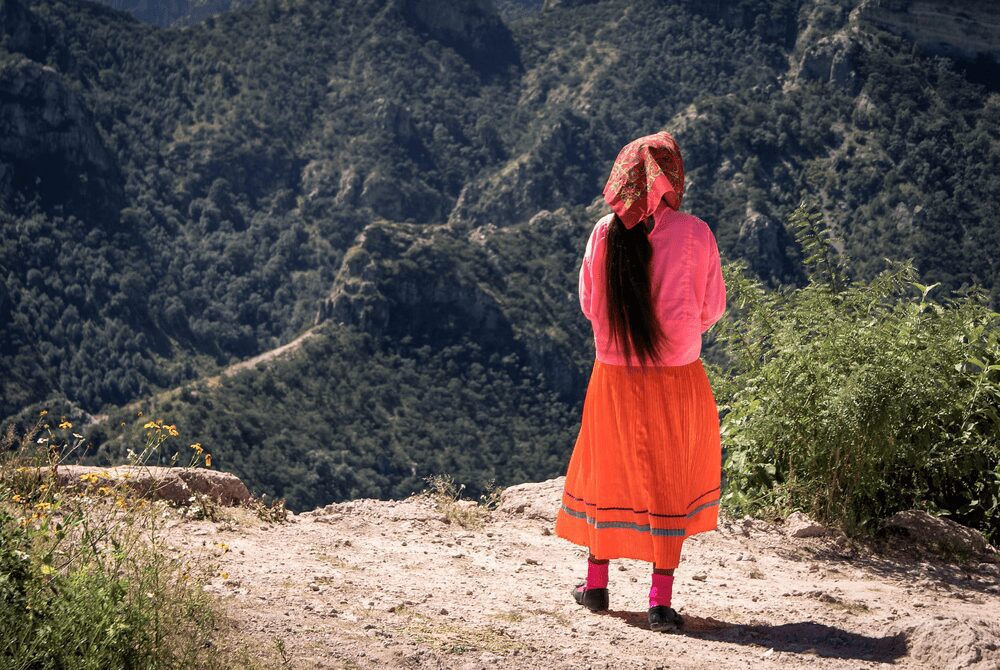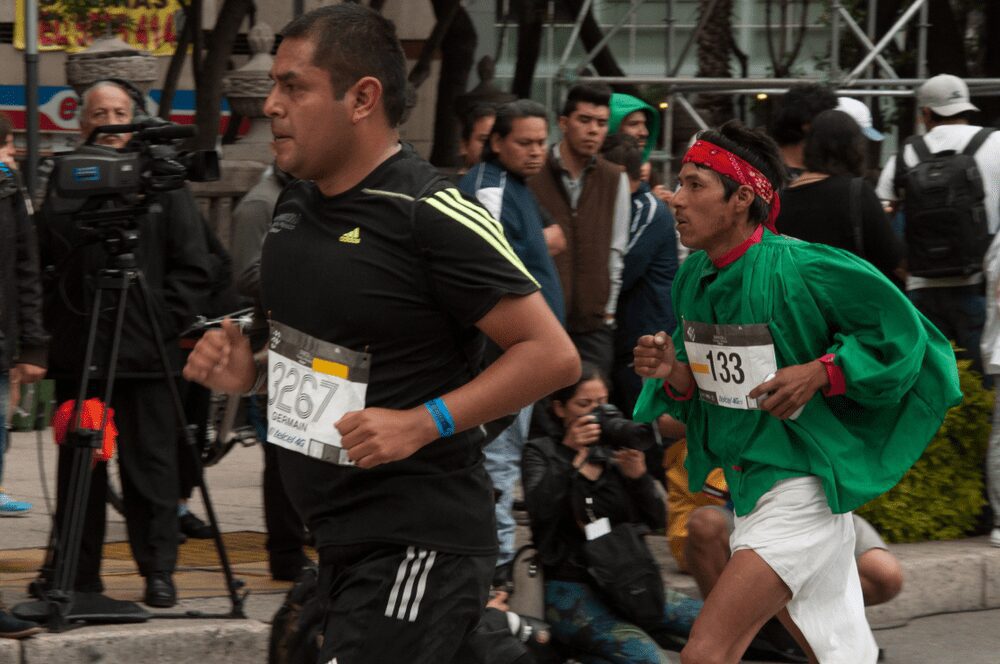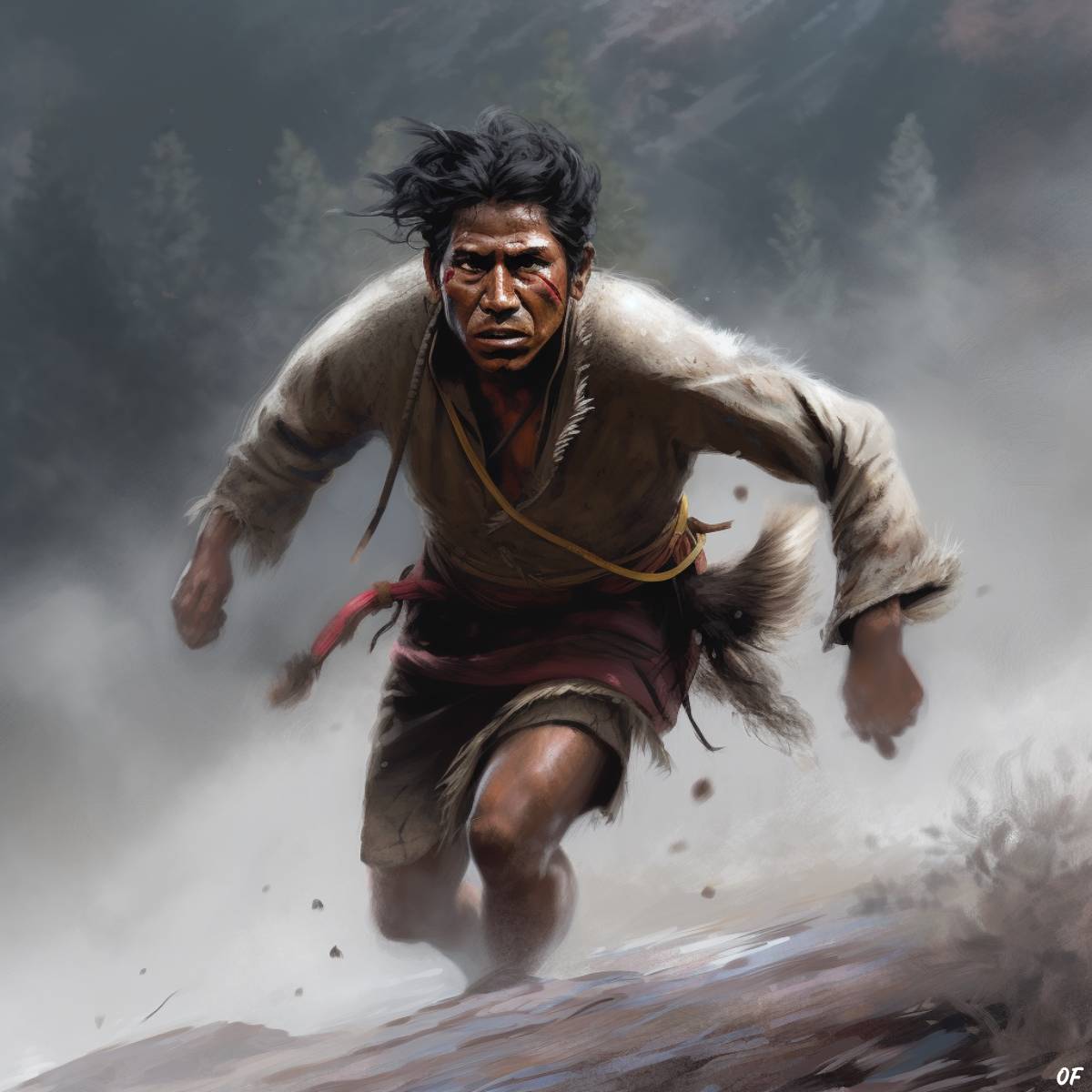Amidst the rugged landscape of the high Sierras in Chihuahua, Mexico, there lives a people that have been called “superhuman” for their extraordinary running capabilities.
The Raramuri, or Tarahumara, rose to infamy with Christopher McDougall’s bestselling book Born to Run. They have wowed the running world by breaking ultramarathon records while barely breaking a sweat. Captivating images of Tarahumara runners like María Lorena Ramírez running races in traditional dress with sandals, hauraches, have made runners and scientists question everything they thought they knew about the sport.
In the 2019 Netflix documentary Lorena, the Light-Footed Woman, Lorena politely declines a gift of running shoes, explaining matter-of-factly:
They feel wrong. I’m not used to running in them. … I don’t think I’ll use them. The people who do are always running behind me.
Beyond the well-earned captivation, the Raramuri have demonstrated a degree of strength and perseverance that goes far beyond athletic feats. Faced with seemingly endless adversity, from conquistadors and mining operations to drought and drug cartels, the Tarahumara culture has endured. Even those forced to flee into the cities maintain their beautiful traditions, including dance, dressmaking, and of course, running.
The true story of the Raramuri is not one of superhuman ability but of the indomitability of the human spirit.

The Rarámuri people’s history of resistance
With a population between 57,000-85,000, the Raramuri are one of the largest indigenous groups in North America. Many still practice a traditional lifestyle, living in the relative isolation of the highlands and canyons of the Sierra Madre Occidental. Inaccessible by vehicle, navigating by foot is the only way to travel here. Far from being viewed as inconvenient, it is a way of life.
Pre-contact population estimates numbered in the millions. Raramuri territory extended throughout the foothills and plains of northern Mexico, untouched for 6,000 years. They retreated further into treacherous terrain during the last 400 years—a migration that was pivotal to their preservation. Jesuit missionaries arrived in the early 1600s with the Spanish conquistadors close behind. Mining operations were already established in the Tepehuán region to the south, where the first rebellion in 1616 would kill over 1,000 indigenous people.
As the Spanish mining frontier moved north into Raramuri territory, many were forced into slavery. A series of uprisings in the mid-1600s broke the Raramuri into two groups. Southernmost villages assimilated, while northern Rarámuri waged war. At enormous cost, they drove the Spanish settlers and missions from the region. This halted further invasion into the northern Raramuri territory for 20 years.
The discovery of silver in the Upper Sierra Madre reignited the Spanish conquest. This was met with another uprising in 1690 that led to the largest and final clash in 1697—a revolt in which the Rarámuri chose death over surrendering to the Spanish.
Europeans didn’t just bring conflict to the Raramuri. Historians estimate as much as 50 percent of the Raramuri population was decimated by foreign diseases like smallpox. If those that were left had any chance of survival at all, they had to isolate themselves rather than continue fighting battles they could not win.
As the Raramuri began to retreat both physically and psychologically, clashes became less frequent throughout the 1700s. The outside world continued to stream into the region throughout the next two centuries. Larger-scale mining and logging operations would devastate the wild landscape, forcing many Raramuri into labor while stripping them of their traditional way of life. The segment of Raramuri society that sought refuge deep in the mountains has preserved their culture to this day, but now faces unrelenting threats from drug trafficking and climate change.

Resilience as a state of being
Attempts at interpreting Rarámuri, the name they have given themselves, have included light feet, foot runners, and those who run fast. The true meaning in their native language gets lost in translation, but its significance is unmistakable.
The ancient origin of Tarahumara running traditions is persistence hunting, in which game was pursued over several days to the point of exhaustion. This meant scaling steep inclines and navigating rocky, winding trails at a steady pace for hundreds of miles. Long-distance running was also the only means of communication between widespread farms and Tarahumara villages. What began as a necessity evolved into a pillar of their culture.
Traditional footraces bring the community together in celebration. Running in this treacherous terrain is difficult enough without any added challenges, but the Raramuri footraces take it to another level. During the rarajípares, teams of men kick wooden balls along the route. Women also run with a stick and hoop in ariwetes. Raramuri elders have described these footraces as a symbolic parallel to “navigating the complex, chaotic journey of life.”
Footraces can last hours or days as the charged communal energy fuels participants. As one Raramuri runner explained:
The best runners participated as actual runners, but the entire community participates by running as helpers, preparing food and tesguino [traditional corn beer], serving runners during the race, cheering, and betting.
Cheers include shouts of Iwériga! —which means both “breath” and “soul” in the Raramuri language. Running is intrinsically linked to their spirituality. Biological anthropologist and marathoner Daniel Lieberman describes the trancelike state of the runners as something far more divine than what we think of as a “runner’s high.”
Running is spiritually meaningful, a form of prayer, a symbol of the journey of life. It is impossible to measure the extent to which these attitudes and beliefs help motivate runners to dig deep and find the strength to keep going for long distances that many people from other cultures find impossible to imagine.
A Raramuri guide named Santiago explained to journalist Will Harlan that running elevates them to a transcendental state. They can mentally tune out the pain as they commune ever closer to the natural world. “Running connects us to our past and our place. … We honor the earth and our ancestors with each step,” he said.
Dancing also has a special place in Raramuri life. Traditional Yúmari dances, which began as rituals before hunting expeditions, are now held before races or other sacred events and can last 1-2 days. The infamous Raramuri ultramarathon runner Arnulfo Quimare was featured in Born to Run. Described in the book as “the greatest living Tarahumara runner,” he explained how dance and running are both sacred forms of meditative movement:
I love to run and my ability to run is God’s gift. … Running always helps me remember who I am as a human. … When we run and dance, we give thanks to God.

Resisting erasure in the modern world
Their physical endurance stems from the same mindset that has kept them resilient through centuries of oppression, but the multitude of threats looming over the Raramuri today pose dire risks to their future.
Climate change has been disastrous in the region. Bouts of cold and frequent droughts have caused massive crop failures, a tragic blow to a culture that has lived in balance with nature for thousands of years. In the Colonia Martín López neighborhood of Chihuahua, around 500 Raramuris live in the government-funded settlement called Oasis. Author Victoria Blanco writes that most Oasis refugees believe the Raramuri God, Onorúame, has caused the droughts back home out of anger. Onorúame is not angry at the Rarámuri, but at the invaders who have come to steal resources and plant “bad crops”—marijuana and poppies.
Once enslaved by the conquistadors, many Raramuri now find themselves enslaved by narcotics gangs. Randall Gingrich is the director of the social and environmental advocacy organization Tierra Nativa. He explains that Tarahumara Indians have been at the mercy of drug traffickers for decades, and it’s getting worse:
Climate change has resulted in these devastating droughts that last months and sometimes even years. So these Tarahumara have no choice to survive but either to migrate out of the region or to stay and grow drugs.
In the early 2000s, drug violence ramped up as cartels fought for control of land in the Sierra Tarahumara region. Spurred by the increasing demand for heroin in the United States, they seized farmland for growing poppies. A changing climate and the drug trade have pushed many Raramuri to flee once again, this time with nowhere to go but into urban centers. An estimated 35,000 have migrated away from their homeland since the 1950s. By 2010, as many as 10,000 fled to the city of Chihuahua alone, where they became easy targets for cartels. Many are lured with the promise of high payouts, or they are kidnapped to work in the poppy fields.
The Raramuri’s incredible running skill is also being exploited to smuggle drugs from Mexico to the U.S. Silvino Cubesare, the internationally known ultramarathoner also featured in Born to Run, was left with no choice after a severe drought left his family starving. Assured the equivalent of three months’ pay for one week of work, he became one of the hundreds of Raramuri caught by the border patrol. Cubesare was arrested and spent eight months in a New Mexico prison. When U.S. border agents released him with no money, it took him another two months to get back home.
The triumph of the Raramuri people’s spirit
When Cubesare ran his first 150-mile race at age 16, the farthest he had run was 10 miles. Like nearly all Raramuri racers, he didn’t even train to prepare. As he told author Christopher McDougall: “I just knew I could do it.”
A few years after being coerced by drug traffickers, the exposure from his story in Born to Run led to racing invitations from around the world. His career as an ultramarathoner gained momentum, and his winnings helped him to build a home for his family in the mountains. Cubesare also co-authored the research study Running in Tarahumara (Rarámuri) Culture with Daniel Lieberman, frequently referenced in this article.
Increased media coverage helped many other Raramuri gain international recognition for their talent. Raramuri runners now compete in long-distance races around the world. María Lorena, featured in the Netflix documentary, was the first Raramuri woman to compete in a European ultramarathon. Of course, racing does not provide a steady income and does not help the plight of the Raramuri. As people worldwide marveled at their racing stats, the ongoing threats facing the Raramuri were left out of the discussion far too often.
This disconnect was starkly illustrated in 2015, when race organizers had to call off the Caballo Blanco Ultramarathon in Copper Canyon at the last minute. Intense fighting between rival drug cartels had erupted along the route. As most of the visiting runners exited via military escort, over 500 Raramuri resolved to race anyway. Cubesare was amongst the fearless who would not let gang violence interfere with tradition.
Poverty and discrimination await those who have fled to urban centers. Many resort to selling trinkets and candy or must rely on the meager generosity of passers-by. Displaced, outnumbered, and subjected to rampant racism, the Raramuri refuse to abandon their identity under the pressures of assimilation.
On the streets of Chihuahua, Raramuri women are still adorned in magnificent traditional dresses. A group of seamstresses in Oasis are now trying to turn their dressmaking tradition into a source of stable income. Paula Holguin, who left the Sierra Madre when her family’s crops failed, is leading the initiative. Despite having several running medals of her own, she, too, spent many years struggling to feed her family in the city. Holguin petitioned the Mexican government for funds to clear out a workshop in Oasis and supply sewing machines. With vision and persistence, she started a sewing cooperative where Raramuri women could keep their traditions alive while earning a sustainable income.
Running out of time
Physically conditioned by their lifestyle and nurtured by traditions that celebrate movement as a spiritual practice, strength is part of the Raramuri identity. Their harmony with nature and deep connection between body, mind, and spirit is testimony to the immense potential of human beings – if only more of us cared to follow their lead.
After thousands of years of self-sufficiency, the tragedy, oppression, and exploitation they have endured would be soul-crushing for most. Yet, they manage to safeguard their legacy by supporting each other within the community as they have done throughout history.
Today, a lack of governmental protection, the drug trade, and the droning forward march of capitalism threaten to destroy the sacred Sierra Madre homeland and its extraordinary people. Ignorance and greed are winning over authenticity. The sheer willpower of the Raramuri to keep their spirits high and their traditions alive has become an act of defiance against powerful forces erasing the legacy of indigenous peoples.


